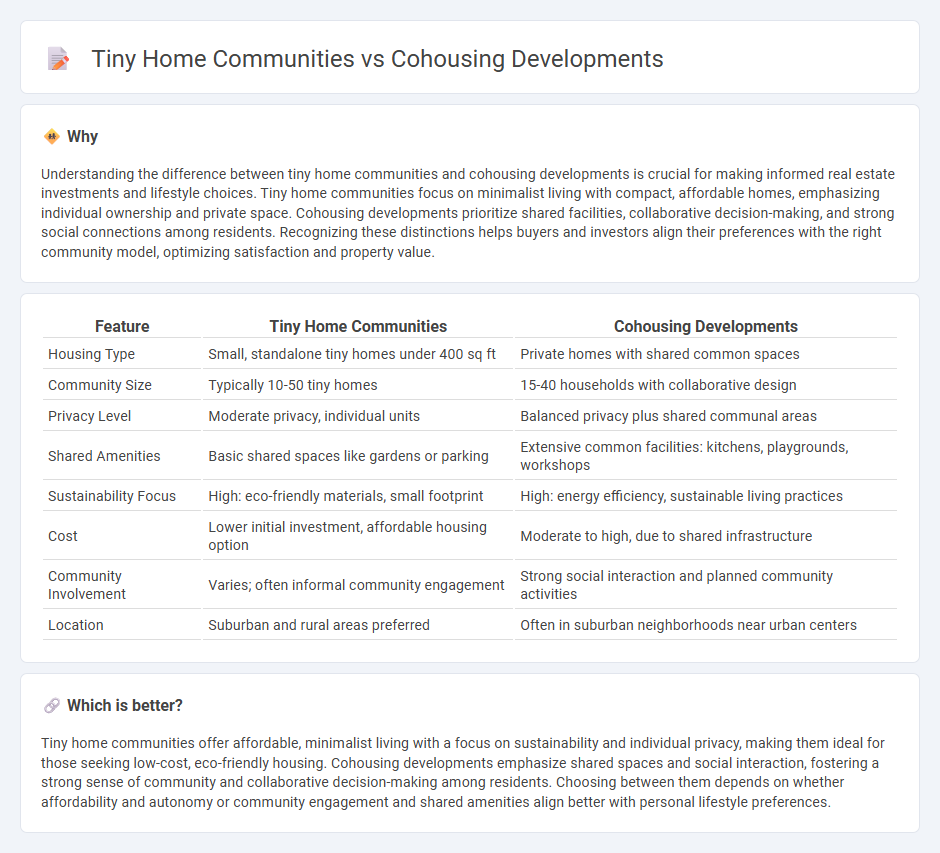
Tiny home communities prioritize compact, affordable living spaces that maximize land efficiency and promote minimalist lifestyles, often appealing to individuals seeking low-cost housing solutions. Cohousing developments emphasize collaborative living, featuring shared amenities and communal decision-making to foster strong social connections while maintaining private homes. Explore the distinctive benefits of each housing model to determine which aligns best with your lifestyle and community goals.
Why it is important
Understanding the difference between tiny home communities and cohousing developments is crucial for making informed real estate investments and lifestyle choices. Tiny home communities focus on minimalist living with compact, affordable homes, emphasizing individual ownership and private space. Cohousing developments prioritize shared facilities, collaborative decision-making, and strong social connections among residents. Recognizing these distinctions helps buyers and investors align their preferences with the right community model, optimizing satisfaction and property value.
Comparison Table
| Feature | Tiny Home Communities | Cohousing Developments |
|---|---|---|
| Housing Type | Small, standalone tiny homes under 400 sq ft | Private homes with shared common spaces |
| Community Size | Typically 10-50 tiny homes | 15-40 households with collaborative design |
| Privacy Level | Moderate privacy, individual units | Balanced privacy plus shared communal areas |
| Shared Amenities | Basic shared spaces like gardens or parking | Extensive common facilities: kitchens, playgrounds, workshops |
| Sustainability Focus | High: eco-friendly materials, small footprint | High: energy efficiency, sustainable living practices |
| Cost | Lower initial investment, affordable housing option | Moderate to high, due to shared infrastructure |
| Community Involvement | Varies; often informal community engagement | Strong social interaction and planned community activities |
| Location | Suburban and rural areas preferred | Often in suburban neighborhoods near urban centers |
Which is better?
Tiny home communities offer affordable, minimalist living with a focus on sustainability and individual privacy, making them ideal for those seeking low-cost, eco-friendly housing. Cohousing developments emphasize shared spaces and social interaction, fostering a strong sense of community and collaborative decision-making among residents. Choosing between them depends on whether affordability and autonomy or community engagement and shared amenities align better with personal lifestyle preferences.
Connection
Tiny home communities and cohousing developments share a focus on promoting affordable, sustainable living through shared resources and communal spaces. Both concepts emphasize minimalism and efficient use of land, fostering strong social connections while reducing environmental footprints. These models often attract individuals seeking a balance between privacy and collaboration, leveraging communal infrastructure to lower costs and enhance quality of life.
Key Terms
Shared Amenities
Cohousing developments emphasize extensive shared amenities such as communal kitchens, gardens, and recreational spaces designed to foster social interaction and collaboration among residents. Tiny home communities often feature more limited shared facilities tailored to support minimalist living, including shared workshops or co-working areas that prioritize privacy and simplicity. Explore the unique benefits and design principles behind shared amenities in these community models to find the best fit for your lifestyle.
Zoning Regulations
Zoning regulations for cohousing developments typically allow for clustered residential units with shared common spaces, emphasizing community-oriented living and sustainable land use. Tiny home communities often face more restrictive zoning challenges due to minimum size requirements, occupancy limits, and land use bylaws that vary widely across municipalities. Explore the latest zoning policies and strategies to successfully navigate these developments in your area.
Ownership Structure
Cohousing developments feature private ownership of individual homes combined with shared common spaces managed cooperatively, fostering community engagement while retaining personal property rights. Tiny home communities vary widely, from owner-occupied units with deeded land to rental models where residents lease their tiny homes or lots, influencing long-term equity and control. Explore further to understand how ownership structures impact community dynamics and investment security in these housing alternatives.
Source and External Links
Building Community with Cohousing - This article discusses cohousing as an intentional community with shared spaces and values, offering a more environmentally friendly and connected way of living.
Cohousing - Cohousing is a type of intentional community where residents live in private homes with shared common areas and involve collective resident control and stewardship.
The Cohousing Company - Cohousing communities are designed to be environmentally sustainable with features like shared facilities and energy-efficient systems, reducing energy consumption and waste.
 dowidth.com
dowidth.com